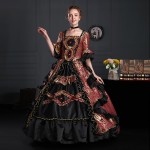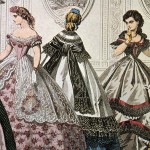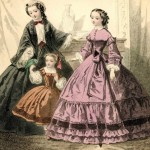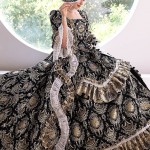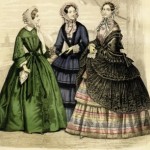Victorian Era Women’s Fashion Dresses Gowns
During the initial years of the Victorian rule, namely the 1840 and 1850 period, the gowns worn by women were narrow and had sloping shoulders. They also had low but pointed waists and bell-shaped skirts. Women wore corsets, which reached up to the knees and layers of petticoats under their gowns. Later on, pantalettes and crinoline were used instead of petticoats and chemise.

1840s/1850s victorian fashion
The reason for this change was that the size of the skirts had expanded and so pantalettes was more suited to this new change. The dresses worn by women during the day had a solid bodice. For the evening occasions, the Victorian women had some liberty as they could bear the shoulders and upper part of the chest. This apparel was completed by a shawl and opera-length gloves.
This was the case of upper and middle-class women. Shawls also formed a part of the Victorian costume. By 1860, the skirts were flat at the front. The day dresses had pagoda sleeves and a high neckline. These necklines either had lace or tatted collar on them. However, for the evening wear, the gowns had a low neckline and short sleeves along with appropriate gloves.
Somewhere in 1870, tea-gowns were introduced for casual get-togethers at home. By 1867 Crinoline was replaced by Bustles to hold the skirts up. The invention of the sewing machine in the late 18th century enabled women to wear sewn clothes. The use of machine brought about a lot of change in the clothing fashion.

1840s ball gowns
Victorian era women’s wear timeline
1830s dress style
During the early years of Queen Victoria’s reign in 1837, the ideal shape of the Victorian woman was a long slim torso emphasised by wide hips.
To get a low and slim waist, tightly laced corsets were used that extended over the abdomen and down towards the hips. The corset was commonly worn over a chemise. The tight-fitting bodice with a low waistline was over the corset. Read more about history of Corsets and Corset Punishments.. Read more about history of Corsets and Corset Punishments.. A long skirt accompanied the bodice, with layers of horsehair petticoats worn underneath to create fullness; emphasising the small waist. The narrow waist was contrasted by low and straight necklines.
Women’s dresses had larger sleeves than were worn in any period before or since and were accompanied by elaborate hairstyles and large hats.

1830s victorian fashion
1840s dress style
Key features were low neckline, collapsed sleeves, elongated V-shaped bodices, and fuller skirts.
Skirts lengthened with increased width with the arrival of the horsehair crinoline in 1847; which became a status symbol of wealth.
More layers of flounces and petticoats emphasised the fullness of the wide skirts. Skirts were attached to bodices with very tight organ pleats secured at each fold. This served a decorative purpose for a relatively plain skirt. The 1830s was flamboyant whereas 1840s style was perceived as conservative and “Gothic” compared to the 1830s.

1840s victorian fashion
1850s dress style
Day dress necklines dropped even lower into a V-shape. So the bust area was covered with a chemisette.
Evening dress featured a Bertha, exposing the shoulder area instead. Bodices extended over the hips, sleeves opened further and increased in fullness. The volume and width of the skirt increased even further, especially during 1853 with the addition of rows of flounces. The invention of synthetic dyes introduced new colours to garments and women tried gaudy and bright colours.
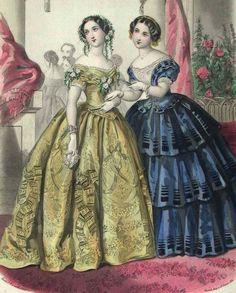
1850s victorian fashion
1860s dress style
Size of crinolines decreased in size at the top, but retained their amplitude at the bottom.
Its shape became flatter in the front and more voluminous behind.
Bodices ended at the natural waistline, had wide pagoda sleeves, high necklines and collars for day dresses and low necklines for evening dresses.
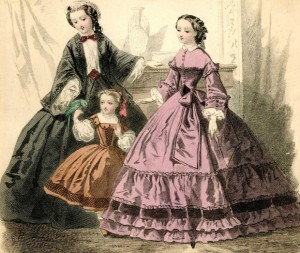
1860s victorian fashion
1870s dress style
Broad skirts trend slowly vanished in the and women prefered an even slimmer silhouette. Bodices had natural waistline, necklines varied, and sleeves began under the shoulder line.

1870s victorian fashion
1880s dress style
The bustle re-appeared in 1883, and featured a further exaggerated horizontal protrusion at the back. Drapery moved towards the sides or front panel of the skirt and at the back was lifted up into poufs. Bodices were shortened and ended above the hips.

1880s victorian fashion gown dress
1890s dress style
By 1890, the crinoline and bustle were completely abandoned. Skirts naturally flared away from the tiny waist and evolved into a bell shape. High necklines, sleeves of bodices peaked at the shoulders, which increased in size during 1894.
After the mid-19th century
three important events impacted women’s fashion.
1. The invention of the sewing machine – speed and quality of sewing improved dramatically.
2. The invention of synthetic dyes – it created intense fabric colours
3. Bustles – the fashionable shape of crinolines changed with a flat front, in time for the arrival of the bustle.
By 1883 the bustles became really popular. It was an uncomfortable garment which made sitting in the chair difficult.
Dresses in this period were strictly regulated, and the incorrect dress would mean getting censured from the influential ladies of high fashion.
More About Victorian Era Women Fashion
- Development of Victorian Fashion Do you know Victorian fashion ? Do you know Victorian costumes how to development?
- The Crinoline or Hoop Skirt for Victorian Dresses 1850s 1860s 1870s 1880s 1890s Petticoat Crinoline
- Victorian Dresses Ball Gowns- 1844-48 History of 1840s Victorian Ball Gown
- 19th Century Victorian Fashion – 1840s to 1890s History of 19th Century Victorian Women Fashion Dress
- Victorian Era Women Dresses History of Victorian Style Dresses Ball Gown 1830s-1890s
- Where to buy Victorian Dresses Buy Authentic Historical Victorian Dresses
- where can I buy queen victoria’s wedding gown? 17th 18th Century Victorian Wedding Gowns
- How to make a Victorian Dress? Create a Victorian-style dress
- Why were Victorian era dresses so big? The petticoats culture of Victorian fashion
- How did women dress in the Victorian era ? Victorian era fashion underwent significant changes
